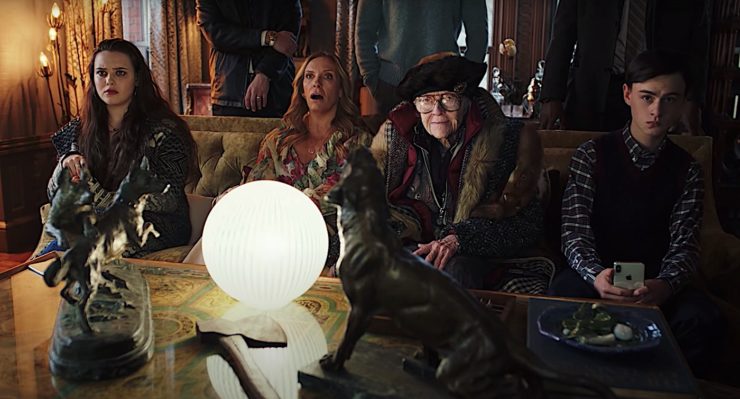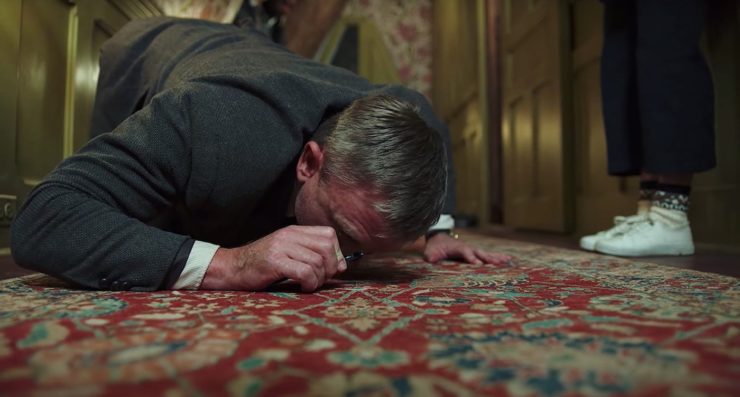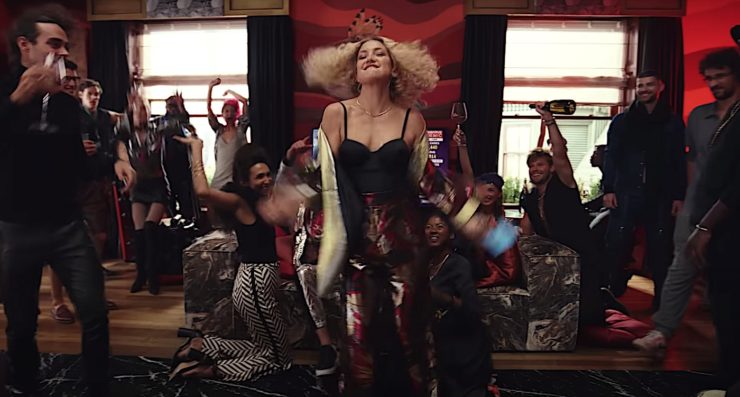Welcome to Close Reads! In this series, Leah Schnelbach and their guests dig into the tiny, weird moments of pop culture—from books to theme songs to viral internet hits—that have burrowed into our minds, found rent-stabilized apartments, started community gardens, and refused to be forced out by corporate interests. This time out, Sarah Welch-Larson looks at the role of technology in the mysteries of Rian Johnson.
Rian Johnson’s murder mysteries are interested primarily in money and power—and in the people who have both, and who serve as the center of gravity for everyone else around them. Mystery stories have been exploring these ideas forever: Hercule Poirot’s most famous adventures take place on luxury transportation; Lieutenant Columbo matches wits with rich and high-class murderers. Murder mysteries from Sherlock Holmes to contemporary TV procedurals tend to circle around the social standing of the murder victim; if they were well off, their status is usually a factor in their demise, while wealthy murderers in these stories tend to kill in order to preserve their own status quo. Knives Out, Glass Onion, and Poker Face all add the complexity of characters who believably exist online just as well as they do in real life.
[spoilers follow for Knives Out, Glass Onion, and Poker Face.]
The Benoit Blanc mysteries are smart and playful, telegraphing their intentions through their rich production design. The writing and casting for both films are good—it’s a delight to see character actors make a meal of Johnson’s wordplay—but the series finds true depths with its visual work. Elaborate wallpaper and eccentric knickknacks cover every surface of Harlan Thrombey’s (Christopher Plummer) mansion in the original Knives Out. Fine art and high-tech gadgets pepper the lush Greek villa inhabited by billionaire innovator Miles Bron (Edward Norton) in Glass Onion. Jenny Eagan’s costume design informs the characters who roam these estates: the careless rips in Ransom Drysdale’s (Chris Evans) Aran sweater testify to the way he’s used to throwing money around, while Birdie Jay (Kate Hudson) wears a metallic rainbow dress that speaks to her desire to be the center of attention.
Buy the Book
Emergent Properties
Poker Face takes this same sensibility and serializes it for television, building its “howcatchem”-style mysteries around memorable characters and the guest stars who play them. Place, setting, and costume here are all just as important as they are in the Benoit Blanc mysteries; production designer Judy Rhee and costume designer Traci Gigi Field both give the series a cohesive, lived-in, 70s-style sensibility, while playing up the particulars of each episode’s setting: “Rest in Metal,” which follows a washed-up one-hit-wonder band on tour, has a layer of ordinary drabness to it, while “The Stall,” which centers around a Texas barbecue pit, is decorated and shot with the same polished sheen of a Food Network special dedicated to the art of smoking meats.
As with the Benoit Blanc mysteries, Rian Johnson is interested in exploring the identities of his characters in full, beyond the simple either/or question of murder victim vs. suspect. This attention to detail, and attention to the act of attention itself, extends to each episode’s plot structure. Poker Face isn’t focused on answering the question of who did the murder, or why. The audience knows these answers right from the start. Poker Face dedicates its time first to establishing the stakes of the story, then watching human lie detector Charlie Cale (Natasha Lyonne) unravel the mystery for herself. In effect, the attention is redirected from centering only around the person who committed the crime, to focusing on the context of the crime, and on the person who’d been murdered. It’s a more equitable form of murder mystery than the whodunnit, which resolves once the finger of justice has been pointed at the correct culprit. In all of Johnson’s mysteries, each of these characters want to gain—or maintain a hold on—power and attention and the money that comes along with both.

The lived-in sensibility of Poker Face and the lush design of the Benoit Blanc mysteries help make these stories believable, but the most important prop in all of these mysteries isn’t colorful costumes or elaborate set dressing, it’s an ordinary smartphone. It’s the perfect murder mystery suspect: ubiquitous enough that it’s easy to overlook and underestimate. We all carry one. We’re used to seeing smartphones everywhere, so we don’t notice when they appear on screen in a manner that reads as true-to-life. The smartphones in Rian Johnson’s mysteries aren’t typically central to the mystery driving the plot, but like the rest of the costume and production design, the smartphones are vital parts of the equation. They’re tiny glowing mirrors, reflecting truths about the characters who carry them, and, by extension, reflecting truths about the ways we project versions of ourselves online.
Like the rest of the production design, the smartphones in these stories help to inform the audience about the characters who carry them. Alt-right teen troll Jacob Thrombey (Jaeden Martell) rarely looks up from his phone, his pale face lit by the glow of a screen whenever he appears in the background. Before she goes off the grid, Charlie’s phone is her constant companion; when she isn’t working, she’s scrolling through the news, watching current events go by like ripples in a stream. Kate Hudson’s Birdie keeps getting into trouble for running her mouth on Twitter (“I tell it like I see it,” she says: the mantra of anyone willing to sacrifice sensitivity for attention). Influencer and skincare guru Joni Thrombey (Toni Colette) asks another character to “DM me on Instagram” in order to get in touch; manosphere Twitch streamer Duke Cody (Dave Bautista) has Google alerts set for everything that interests him (including, hilariously, an alert for the word “movies”). Marta Cabrera (Ana de Armas) carries a phone with a shattered screen, proof of her economic status as a registered nurse trying to make ends meet.

Even the absence of smartphones is notable. Gentleman sleuth Benoit Blanc (Daniel Craig) doesn’t carry one—he prefers to rely on the evidence he can gather with his own senses unmediated. Charlie abandons her phone when she goes on the road, effectively turning herself into a non-person who can’t be tracked because she has no digital footprints. And Edward Norton’s Miles Bron hides behind an affectation of not carrying a smartphone. He prefers to use fax machines instead, a method of forcing other people to communicate with him on his own terms, in a way that’s inconvenient for them.
All of the characters in these movies have a persona and a true self: the person they claim to be, including online, and the person they really are. Part of the fun is piecing together the mystery at the core of each story, but the explanation of who and how feels secondary to the why of each of these characters. (Poker Face sidesteps the whodunnit aspect entirely, zeroing in on its characters’ presentations of themselves from the start.) The way the characters present themselves online, and how they talk about their online lives, reveals more about their motivations than they would care to admit out loud and in person. Toni Colette’s Joni, upon meeting Benoit Blanc for the first time, exclaims “I read a tweet about a New Yorker article about you.” She’s more interested in breezing through life, passing herself off as a thinker who reads prestigious weekly magazines, but incapable of the self-awareness to know that what she’s actually saying is quite shallow. Likewise, Chris Evans’ character Ransom presents himself as a fashionable rich jerk, but his accusation that Marta is infringing on his “birthright” when she inherits the Thrombey estate reveals that Ransom’s entitlement is borne partially from the seeds of racism.

The revelation that Marta has inherited the Thrombey estate illustrates Johnson’s grasp of existing online, and what a two-edged sword that level of connection can be. Marta leaves the house in a daze, the camera placing her in the middle ground of the frame, distant and lost, stunned by the contents of the will. Then Linda Thrombey (Jamie Lee Curtis) follows her out of the house with an accusatory finger brandished, and the camera rushes in to meet both in shaky handheld urgency, turning to reveal the rest of the family close behind Marta and Linda. The family swarms around Marta in a cacophony, their voices overlapping with each other as they threaten and plead with a woman they’ve taken for granted up until this point. Jacob Thrombey livestreams the confrontation, turning Marta’s distress into an online spectacle. His camera makes her an object for other people to consume for entertainment. Marta is forced to physically leave the premises—in effect, to disconnect—before she can start to process what just happened.
Another, similar scene serves as the climax of Glass Onion. Helen (Janelle Monáe) confronts Miles Bron about his shutting out—then murdering—his former business partner Cassandra, Helen’s twin sister. Everyone else in Miles’ inner circle has seen the evidence of his wrongdoing, but they’re unwilling to back Helen up, because if they do, they’ll lose out on the money and access that Miles can give them. So Helen starts smashing things. Miles’ dining room is filled with glass sculptures on pedestals, empty signifiers of Miles’ supposed taste. For Helen, the action is cathartic, a way to express her anger at a system of power that she can’t breach herself. Then the others in Miles’ circle start joining in, breaking glass sculptures and making fools of themselves in the process. Birdie breaks a single sculpture, then lets out a primal scream, drawing more attention to herself than to the injustice she’s supposedly protesting. The scene brings to mind the myriad accounts who posted black squares to Instagram at the height of the 2020 protests of George Floyd’s murder: perhaps well-meaning, but empty gestures of solidarity without actual work to create change all the same. The inner circle remains in Miles’ pocket until it is no longer profitable for them to do so: a hollow victory for Helen and a demonstration of moral hypocrisy for everyone else.
Performance and spectacle are the central driving forces in Poker Face. Like magicians, the murderers of Poker Face try to misdirect from their deeds by giving the people around them something else to look at. The washed-up TV stars in “Exit Stage Death” fake a backstage argument as an alibi; the culprit in “The Future of the Sport” orchestrates an ugly car crash. The suspects and victims work in industries that require some form of showmanship: stock car drivers, actors, movie producers, musicians, even a TikTok star. Charlie can break the veneer of verisimilitude with her ability to tell if someone’s lying, but the burden of proof rests on her ability to find the cracks in the performance, the “tells” that she can point to in order to prove to other people that her suspects are not who they claim to be. These “tells” revolve around physical and online evidence: the technologies that the culprits use in order to pull off their murders, and the ways they betray themselves by behaving differently online than in real life. One case is even cracked via an eBay listing.

Rian Johnson’s mysteries are examinations about the forces of money, power, and influence, and about who’s good at wielding them, and who’s stuck in the gravitational pull and unable to get off the ride. Both of the Benoit Blanc movies underline their observations by integrating the online lives of their characters into their real-life personas. Poker Face takes a lighter touch by necessity, since its main character intentionally avoids smartphone use, but Charlie’s rejection of technology underlines the ways that her murder suspects betray themselves with their own use of technology. If the endings of each of these mysteries feel a little too clean—the protagonists get a taste of justice, and the villains all reap what they sow—it’s because Johnson is holding up the screen up to our own faces, another mirror of wish fulfillment and a dream of what we’d like society to be.
Sarah Welch-Larson is interested in feminist theory and theology, sad men in space, and stories about agency and creation, especially when they include cyborgs or androids. She is the co-host of the Seeing & Believing podcast, a staff writer at Bright Wall/Dark Room, and the author of the book Becoming Alien: The Beginning and End of Evil in Science Fiction’s Most Idiosyncratic Franchise. She lives in Chicago with her husband, their dog, and about three dozen houseplants.










